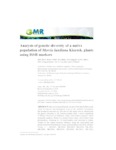Use este identificador para citar ou linkar para este item:
http://www.alice.cnptia.embrapa.br/alice/handle/doc/1061458Registro completo de metadados
| Campo DC | Valor | Idioma |
|---|---|---|
| dc.contributor.author | ALVES, M. F. | pt_BR |
| dc.contributor.author | NIZIO, D. A. C. | pt_BR |
| dc.contributor.author | BRITO, F. A. | pt_BR |
| dc.contributor.author | SAMPAIO, T. S. | pt_BR |
| dc.contributor.author | MUNIZ, A. V. C. da S. | pt_BR |
| dc.contributor.author | ARRIGONI BLANK, M. F. | pt_BR |
| dc.contributor.author | CARVALHO, S. V. A. | pt_BR |
| dc.contributor.author | BLANK, A. F. | pt_BR |
| dc.date.accessioned | 2017-01-23T11:11:11Z | pt_BR |
| dc.date.available | 2017-01-23T11:11:11Z | pt_BR |
| dc.date.created | 2017-01-23 | pt_BR |
| dc.date.issued | 2016 | pt_BR |
| dc.identifier.citation | Genetics and Molecular Research, Ribeirão Preto, v. 15, n. 4, 2016. | pt_BR |
| dc.identifier.uri | http://www.alice.cnptia.embrapa.br/alice/handle/doc/1061458 | pt_BR |
| dc.description | Myrcia lundiana Kiaersk. is a tree of the family Myrtaceae found in tropical and subtropical areas of the southern hemisphere that produces essential oil. The aim of this study was to characterize the genetic diversity of M. lundiana plants from a native population of Parque Nacional de Itabaiana, using inter-simple sequence repeat molecular markers. Thirty-five primers were tested, 20 of which were polymorphic, resulting in 135 polymorphic and informative bands. Results of the cluster analysis, obtained using the unweighted pair group method with arithmetic mean, grouped plants into three clusters: Cluster I - MLU001, MLU002, MLU003, MLU004, MLU005, MLU006, MLU018, MLU019, LU020, MLU021, LU022; MLU008, MLU011, MLU012, MLU014, MLU015, MLU017, MLU026, and MLU028; Cluster II - MLU007, MLU009, MLU010, MLU013, and MLU016; and Cluster III - MLU023, MLU024, MLU025, and MLU027. Jaccard similarity coefficients for pair-wise comparisons of plants ranged between 0.15 and 0.87. MLU014 and MLU015 presented low genetic diversity, with a similarity index of 0.87. Conversely, MLU007 and MLU019 presented high diversity, with a similarity index of 0.15. According to the structure analysis, three distinct clusters were formed. Genetic diversity of M. lundiana plants was intermediate, and expansion of its genetic diversity is necessary. MLU026 and MLU028 are the most suitable for selection in breeding programs, since they clearly represent all of the diversity present in these plants. Moreover, these results provide important information on the existing genetic variability, highlighting the importance of Parque Nacional de Itabaiana for the conservation of this species. | pt_BR |
| dc.language.iso | eng | eng |
| dc.rights | openAccess | eng |
| dc.subject | Canela-de-tabuleiro | pt_BR |
| dc.title | Analysis of genetic diversity of a native population of Myrcia lundiana Kiaersk. plants using ISSR markers. | pt_BR |
| dc.type | Artigo de periódico | pt_BR |
| dc.date.updated | 2018-01-26T11:11:11Z | pt_BR |
| dc.subject.thesagro | Planta medicinal | pt_BR |
| dc.subject.thesagro | Genética | pt_BR |
| riaa.ainfo.id | 1061458 | pt_BR |
| riaa.ainfo.lastupdate | 2018-01-26 -02:00:00 | pt_BR |
| dc.contributor.institution | ANA VERUSKA CRUZ DA SILVA MUNIZ, CPATC. | pt_BR |
| Aparece nas coleções: | Artigo em periódico indexado (CPATC)  | |
Arquivos associados a este item:
| Arquivo | Descrição | Tamanho | Formato | |
|---|---|---|---|---|
| AV5.pdf | 823,43 kB | Adobe PDF |  Visualizar/Abrir |









